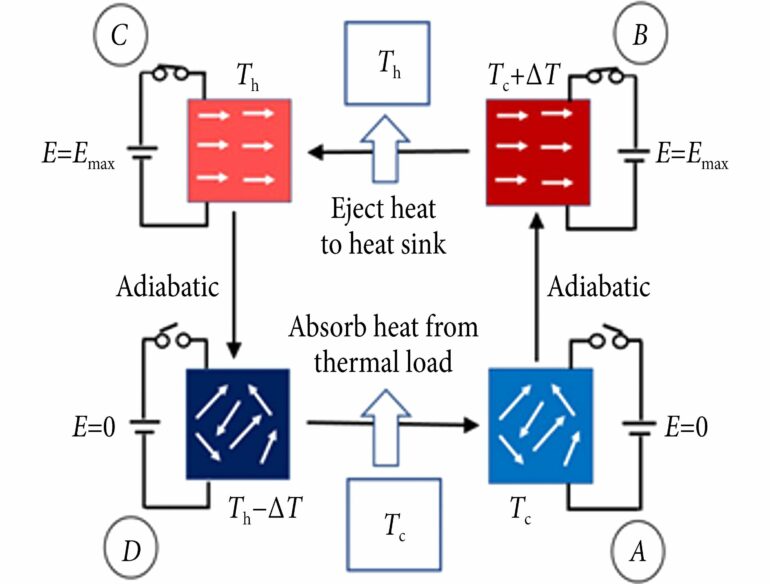As necessary as cooling technologies are, we’re still operating on an outdated technology that can be considered a significant contributor to global warming and greenhouse gas emissions. Currently, vapor compression cycle-based cooling (VCC) is the standard for reliable cooling of air conditioning and refrigeration, but by switching to electrocaloric cooling (EC) researchers are hoping to create a more environmentally friendly, scalable and compressor-free method of cooling to benefit businesses, families and the environment.
The researchers published their work in iEnergy on June 29. The study highlights the electrocaloric effect (ECE) and how it can work to produce a cleaner, high-efficiency way of cooling without all of the harmful greenhouse gas emissions that a standard VCC process would add to the atmosphere.
The ECE can be explained as a reversible change of a dielectric material when it’s been exposed to a controlled change in the applied electric field. A dielectric material, like ceramic which is used in this study, poorly conducts electricity but supports electrostatic fields, which is the catalyst for changing the polarization, or charge, of a field to induce the desired results of cooling. The reversible nature of this change allows for heat distribution and cooling to occur.
In order to have a large ECE the change in entropy needs to be sufficiently large, too. Entropy can be quantified as thermal energy that is ready to be made useful by converting it into mechanical work.
This is where ferroelectric materials become advantageous to use. To have a high-efficiency product, the desired “operating window” where the largest change in the electrostatic field can be achieved, is just above the ferroelectric-paraelectric phase transition. Essentially, this transition phase consists of two oppositely “charged” polarized fields, yielding the large change in entropy, or disorder, needed.
“These EC materials and device research reveals the promise of ferroelectric materials in generating giant ECE at low electric fields and EC cooling devices achieving high performance,” said Q.M. Zhang, first author and researcher of the study.
Simply put, the EC material used is heated past the temperature of the heat sink, and when the two materials make contact, a temperature equilibrium is reached; this is achieved by putting the energy into the field around the objects, not the objects themselves. By using ferroelectric materials a large ECE can be seen under relatively low electric fields which can achieve a compressor-free system, lending to a cooling device that can be much more scalable to meet the needs of families and businesses alike.
“The electrocaloric cooling is attractive as an alternative to the VCC cooling. EC cooling is environmentally benign, compressor-free, highly scalable, and has the potential of achieving higher efficiency than VCC cooling” Zhang said.
While EC cooling is still being developed and researched as a practical way of cooling, a large portion of work that can be done on the EC coolers is developing lead-free materials, as currently the best-performing EC ceramics are lead-based. The lead-based ferroelectrics generate a higher amount of cooling in a shorter amount of time, but lead is a toxic substance, and generally, its use will not be well received by the public.
Another goal is to improve the thermal conductivity of the EC coolers. Since using lead isn’t the optimal choice, the performance of the ferroelectric component ideally would be improved to reduce heat loss and increase operating power. Achieving these goals and developing EC coolers that can be utilized in commercial and residential areas might aid in the global efforts to reduce greenhouse gas emissions and move forward with cleaner cooling technology.
Xin Chen of the Department of Materials Science and Engineering and the Materials Research Institute at Pennsylvania State University, Wenyi Zhu and Q.M. Zhang of the Materials Research Institute and Department of Electrical Engineering at Pennsylvania State University contributed to this research.
More information:
Xin Chen et al, Electrocaloric cooling technologies for a sustainable world, iEnergy (2023). DOI: 10.23919/IEN.2023.0012
Provided by
Tsinghua University Press
Citation:
A cool way to keep things cool: The electrocaloric effect (2023, July 19)



